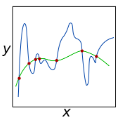Virtual Adversarial Training (VAT) has shown impressive results among recently developed regularization methods called consistency regularization. VAT utilizes adversarial samples, generated by injecting perturbation in the input space, for training and thereby enhances the generalization ability of a classifier. However, such adversarial samples can be generated only within a very small area around the input data point, which limits the adversarial effectiveness of such samples. To address this problem we propose LVAT (Latent space VAT), which injects perturbation in the latent space instead of the input space. LVAT can generate adversarial samples flexibly, resulting in more adverse effects and thus more effective regularization. The latent space is built by a generative model, and in this paper, we examine two different type of models: variational auto-encoder and normalizing flow, specifically Glow. We evaluated the performance of our method in both supervised and semi-supervised learning scenarios for an image classification task using SVHN and CIFAR-10 datasets. In our evaluation, we found that our method outperforms VAT and other state-of-the-art methods.
翻译:虚拟反向培训(VAT)在最近开发的称为一致性规范化的正规化方法中显示了令人印象深刻的成果。VAT利用输入空间中通过注射干扰生成的对抗性样本进行培训,从而增强分类者的一般化能力。然而,这种对抗性样本只能在输入数据点周围一个很小的领域产生,这限制了这些样本的对抗效力。为了解决这个问题,我们建议LVAT(Latent空间增值税)在潜层中注入干扰,而不是输入空间。LVAT可以灵活生成对抗性样本,从而产生更有害的效果,从而更加有效的正规化。在本文中,我们研究了两种不同的模型:变式自动编码和正常化流动,特别是Glow。我们用SVHN和CIFAR-10数据集评估了我们的方法在监督性和半超强的图像分类任务学习情景。我们的评估发现,我们的方法超越了VAT和其他状态方法。



